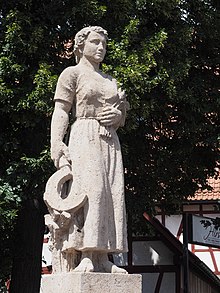
Summary
Katharina Kepler (née: Guldenmann; 8 November 1547 – 13 April 1622) was a woman from Leonberg, Württemberg, who was the mother of the famous astronomer Johannes Kepler. She was accused of witchcraft in 1615, but was defended by her son and released.

Life edit
Katharina grew up in Eltingen. Her father Melchior Guldenmann was an innkeeper and became Schultheiss (mayor, until 1587) of the town when she was 20 years old. She had a female cousin who was burned as a "witch" in Weil der Stadt. Katharina was raised by her parents in the Lutheran faith. Because of her mother's illness, she did not have an easy childhood. She worked in her parents' inn until she got married.
Katharina Kepler was married on 15 May 1571 to Heinrich Kepler and bore seven children from him, four of them she bore survived childhood, one daughter (Margarete) and three sons, first born of them was Johannes Kepler as well as the other two Heinrich and Christoph.
After her husband's death around 1590, Katharina Kepler inherited a house as well as fields and meadows. In 1598 she and her family moved into a small winegrower's house in Leonberg. After the death of her father, who had lived with her for several years and had been cared for by her (in his will he thanked her for the selfless five-year care), Katharina Kepler inherited money. As a single widow, she was financially independent and could support herself and her children. After her youngest children moved out, Katharina lived alone in Leonberg. In 1614, she was listed in the tax register as a tax-paying independent citizen.
Persecution as a witch edit
In 1615, a witch trial was initiated by Lutherus Einhorn who in his reign as Vogt of the Protestant town of Leonberg (1613–1629) accused 15 women of sorcery and executed 8 of them by burning. He acted in accordance with the will of the government and the public, which had asked for an investigation of sorcery, and issued an arrest of Katharina Kepler in 1615. Ursula Reinbold had accused Katharina Kepler of giving her a potion after an argument that had made her sick. Johannes Kepler defended his mother himself, he had sought advice with the assistance from lawyers and theologians of his university of Tübingen.[1] One of his student friends, Christopher Besoldus, assisted her juridically.
Her son took her away to Linz in December 1616. When she returned to Leonberg in the summer of 1620, she was arrested and imprisoned for fourteen months. She was told how she would be tortured, as a means of frightening her, but she refused to confess anything. When she was finally shown the instruments of torture in order to force her to confess, she remained steadfast: "She said that they could do whatever they wanted with her, and even if they pulled out every vein from her body, she would still have nothing to confess ... she would also want to die on that; God would reveal after her death that injustice and violence had been done to her."
Release & death edit
In October 1621, Kepler was able to effect her release. The trial ended with an acquittal. Six months after the end of the trial, in April 1622, Katharina Kepler probably died in Roßwälden. There is no documentary evidence of her burial place.
Reception edit
Although the witch trial against Katharina Kepler was one of the best-documented cases in Germany, it received little attention in research. For a long time, Katharina Kepler was portrayed as an old, witch-like woman. The biography of historian Ulinka Rublack, "The Astronomer and the Witch", changed that. Her work fundamentally revised previous views and provides a new perspective on the Kepler case. The biography shows that the Vogt of Leonberg ignored the legal requirements from the beginning and acted according to his own interests.
Legacy edit
- In 1937, the municipality of Eltingen erected a fountain in Carl-Schmincke-Str. in memory of Katharina Kepler.
- Katharina Kepler is one of the main characters in Paul Hindemith's opera Die Harmonie der Welt (premiered in 1957).
- In 2017, Helmut Jasbar musically processed the story of Katharina and Johannes Kepler in the musical story Eternity for Beginners.
- In 2021, the musical opera Katharina Kepler, which revolves around her witch trial, premiered in Pforzheim. The Pforzheim Theater commissioned the opera from the composer Volker M. Plangg.
- Rivka Galchen's 2021 novel Everyone Knows Your Mother Is a Witch presents a fictionalized account of Kepler's life story.[2]
Literature edit
- Ulinka Rublack (2017). The Astronomer and the Witch: Johannes Kepler's Fight for His Mother. Oxford University Press. ISBN 978-0-19-873678-3.
- James A. Connor (2009). Kepler's Witch – An Astronomer's Discovery of Cosmic Order Amid Religious War, Political Intrigue, and the Heresy Trial of His Mother. Harper Collins. p. 402. ISBN 978-0-06-173742-8.
- Kurt Baschwitz: Hexen und Hexenprozesse, C. Bertelsmann Verlag, München, 1990, pages 252–260
- Berthold Sutter: Der Hexenprozeß gegen Katharina Kepler, Weil der Stadt, Kepler-Ges., 1979
External links edit
- Article „Württemberg, Herzogtum - Hexenverfolgungen” (in German)
- Discussion contribution from the mailing list Witch Research with further links (in German)
- Image of the file extract from the process


